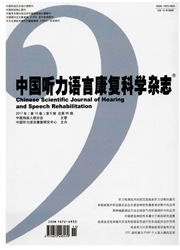

 中文摘要:
中文摘要:
目的:探讨经典Wullstein Ⅲ型鼓室成形术在慢性化脓性中耳炎手术中的适应证及其术后听力效果。方法回顾性分析行开放式Ⅲ型鼓室成形术的患者34例(34耳),患者均有听骨链破坏而镫骨结构完整,鼓膜内陷与镫骨头或砧骨豆状突直接连接,根据术中是否植入钛合金部分人工听骨(partial ossicular replacement prosthesis,PORP)分为两组, Wullstein Ⅲ型鼓室成形术(Ⅲ型组)11例和植入钛合金部分人工听骨(PORP组)23例。分别比较两组术后0.5、1、2和4 kHz的平均气导听阈、平均气骨导差的变化情况。结果Ⅲ型组患者术前平均气导听阈为46.59±16.60 dB HL,术后为34.89±10.34 dB HL,气导听阈提高11.70±19.30 dB HL;PORP组术前平均气导听阈为44.23±12.31 dB HL,术后为37.08±14.36 dB HL,提高7.14±14.39 dB HL;Ⅲ型组术前平均气骨导差(air-bone gap,ABG)为23.98±13.08 dB HL,术后为16.25±6.98 dB HL,缩小7.73±14.93 dB HL;PORP型组术前平均ABG为26.58±10.27 dB HL,术后为19.40±13.28 dB HL,缩小7.17±13.63 dB HL。两组患者在气导听阈提高值及ABG缩小的差异均无显著统计学意义(P>0.05)。结论开放式鼓室成形术中,如果鼓膜内陷与镫骨头或砧骨豆状突形成连接,可以予以保留,短期随访术后听力水平与植入PORP重建听骨链的效果相当,长期效果还需随访观察。
 英文摘要:
英文摘要:
Objective To explore the indication and efficacy of Wullstein typeⅢtympanoplasty in treating the patients with chronic suppurative otitis media. Methods Thirty-four patients (34 ears)were studied who underwent canal wall-down tympanoplasty retrospectively. In all patients, ossicular chain destructions were confirmed during the operation while stapes kept intact with good mobility. The patients were divided into two groups according to the reception of partial ossicular replacement prosthesis (PORP). 11 cases underwent type Ⅲ tympanoplasty (type Ⅲ group) and 23 cases received PORP (PORP group). The average postoperative air-conduction thresholds and air-bone gaps (ABG) were measured and compared at 0.5, 1, 2 and 4 kHz. Results The preoperative air-conduction thresholds for type Ⅲ and PROP groups were 46.59±16.60 dB HL and 44.23±12.31 dB HL, respectively. The postoperative air-conduction thresholds for type Ⅲ and PROP groups were 34.89±10.34 dB HL and 37.08±14.36 dB HL, and the increments of the air-conduction thresholds after the surgery were 11.70±19.30 dB HL and 7.14±14.39 dB HL, respectively. The ABG changes of typeⅢgroup were 7.73±14.93 dB HL, and for PORP group were 7.17±13.63 dB HL before and after the surgery. There was no statistically significant difference between the two groups in the increment of air-conduction thresholds and ABG changes (P>0.05). Conclusion The myringostapediopexy or myringolenticulopexy can be reserved in the wall-down tympanoplasty for it showed equal efficacy in hearing reconstruction with PORP. Meanwhile, further observations are needed for long term outcomes.
 同期刊论文项目
同期刊论文项目
 同项目期刊论文
同项目期刊论文
 期刊信息
期刊信息
